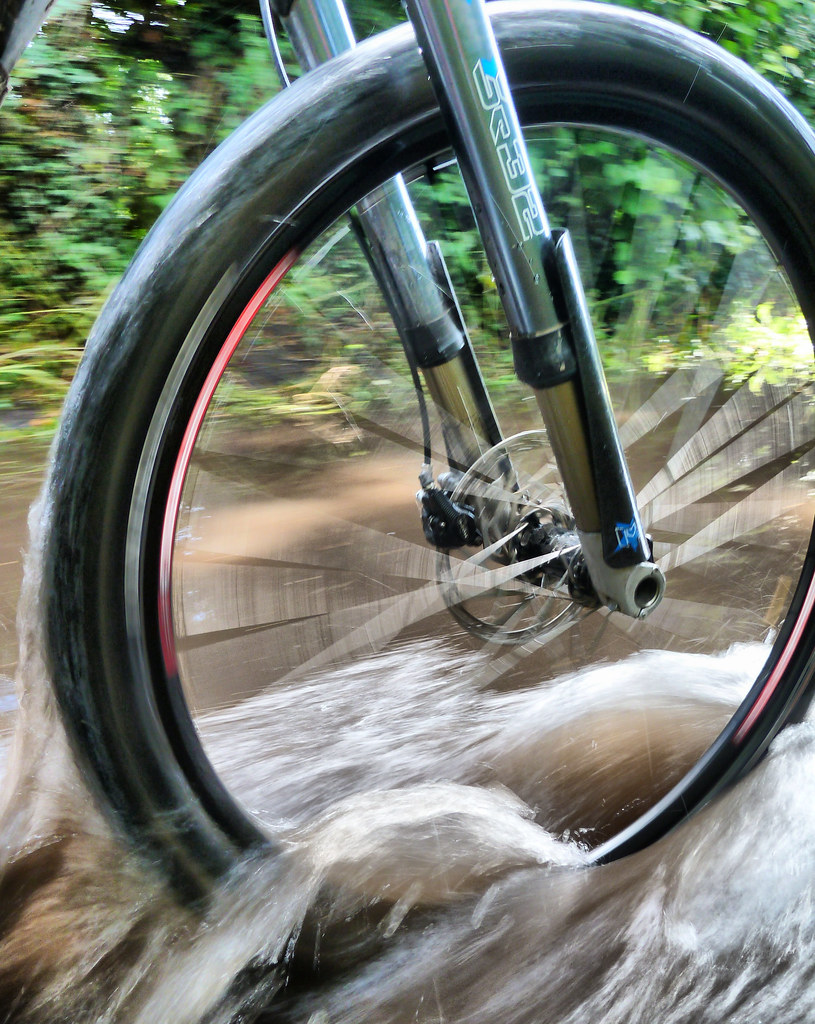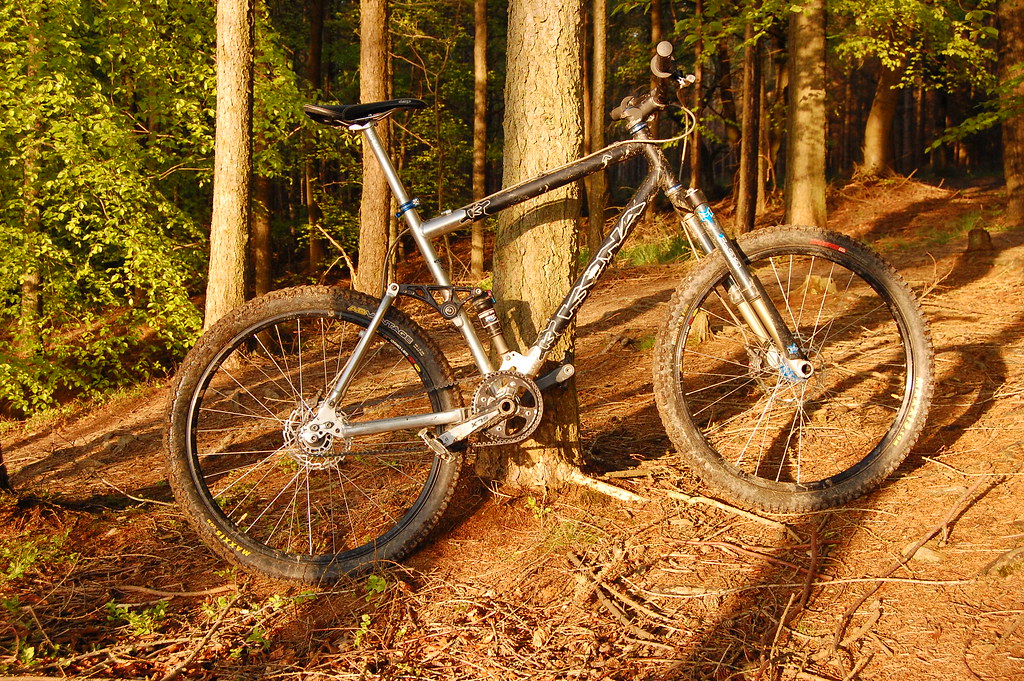Home › Forums › Bike Forum › Upside-Down Forks
- This topic has 37 replies, 26 voices, and was last updated 11 years ago by walleater.
-
Upside-Down Forks
-
patriotproFree MemberPosted 11 years ago
What are the actual benefits of these? You know, like the Manitou Dorado and the new X-Fusion jobs…
Personally I think they look brill but am interested in the actual benefits in use..
What do you lot have to say on the matter?
ndthorntonFree MemberPosted 11 years agofantastic idea – all bike forks should be upside down
If only the new X fusion ones didn’t cost as much as a good car!clubberFree MemberPosted 11 years agoWider tubes at the top/crown where there’s more stiffness benefit
Trouble is many upside down forks have been noodly because of twisting at the hub end – thru axles certainly help here.
ndthorntonFree MemberPosted 11 years agoHas there ever been an upside down fork without a bolt through axle??
Noodlyness is the only real problem that people seem to complain about – makes sense with the single crown ones. But surely not beyond the wit of man to sort out – Id be surprised if X-fusion haven’t managed it for a grand!
CaptainFlashheartFree MemberPosted 11 years agoHas there ever been an upside down fork without a bolt through axle??
Halson Inversion

Mountain Cycles Suspenders
asterixFree MemberPosted 11 years agodidnt the motorcycle world go through the transition to upside down forks years ago?
honourablegeorgeFull MemberPosted 11 years agoYou can’t have the arch across the lowers with an inverted fork. Other than that, there’s all sorts of small benefits like less unsprung weight, more oil around the seals, etc.
hopefiendboyFull MemberPosted 11 years agothe other issue can be that the stantions are lower down closer to any obstacles / rocks and can be easily damaged unless they have guards.
mindmap3Free MemberPosted 11 years agoThe Shiver’s that I had on my Bog Hit were ace – they were so sensitive to bumps etc and felt great. I didn’t think that they were that flexy (certainly not as bad as people who had never ridden them made out). Only downside was that they weighed loads.
Stanchion guards were great for putting stickers on too!
The whole stiffness thing is interesting because we must be getting to a point where things are almost getting too stiff. Some flex is surely a good thing (i.e. it means that some bumps / vibrations are taken up by components rather than being transmitted to the rider).
sharkattackFull MemberPosted 11 years agoThis is how you build an upside down fork;

Add a brace and protect the stanchions. Two inherent problems solved.
julianwilsonFree MemberPosted 11 years ago^^ makes you wonder why no one tried it before! (looks?) iirc DVO claim that even though the ‘carbon torsion arch’ in the stanchion protectors is relatively insubstantial/light, it still makes a significant difference to stiffness/twistiness of the fork. They said this was the case for years on upside down forks on some high end motorcycles which have a mudguard that links the stanchion guards, and that was why they tried it for a bicycle (albeit without mudgard).
£1800 quid for the fork, mind 😯 😯
honourablegeorgeFull MemberPosted 11 years agoI keep looking at that bike and thinking “surely they could have found a black chain guide?”
thisisnotaspoonFree MemberPosted 11 years agodidnt the motorcycle world go through the transition to upside down forks years ago?
Yes, but it was (and still is) the case that the USD forks weighed considerably more to keep them stiff (less of an issue on a 150bhp bike Vs a 1/8th of a horsepower one!) and didn’t work as well, something to do with damper arangements.
Look at bikes like the R6 where weight/handling was more a priority and they hung onto conventional forks for a few years past USD forks becoming the norm.
Orange-CrushFree MemberPosted 11 years agoMy first motorcycle (a 1950’s job) had upside down forks but “modern” motorcycles have seen upside down forks come and go, as fashion dictated, over the last thirty years. It’s doubtful if any difference can be felt by the majority of users in terms of it affecting how they use the bike, which I would guess will also apply to the pedal cycle version.
geordiemick00Free MemberPosted 11 years agoUSD forks were introduced into the motorbike world to make last years model look so out of date and so inefficient. Then a year later when the power rangers who had clocked up an all impressive 1500 dry miles in 12 months, the motor trade would offer them a pittance for their mint nick bike knowing they just had to have the next model because it had another gimmick, which after USD forks was radially mounted brake callipers.
What we are seeing here is market(ing) forces.
THe only benefit I see to USD MTB forks is the LBS’s will clean up selling new fork seals after the owners have learnt the lesson of neglect, corrosion and stone damage to the lower fork stanchions
NorthwindFull MemberPosted 11 years agoLubricating oil sits on the seals instead of relying on splashing around. Sort of like storing your forks upside down. Supposed to be less unsprung weight but it doesn’t automatically follow.
And yep, agreed on motorbike stuff- not sure if big pistons etc would work with rwu forks but if you compared say a Showa USD and RWU from a SRAD 600 and 750 there was bugger all performance difference but everyone wanted the USDs. (er, including me, I had the choice and went with USDs because I’m a tart)
butterbeanFree MemberPosted 11 years agoLargely b*llocks, done for the sake of trying to be different.
USD DH forks on a UK uplift = carnage.
russjpFree MemberPosted 11 years agoMy old shiver single crowns were so flexy that it was a nightmare balancing in 4X start gates.
rOcKeTdOgFull MemberPosted 11 years ago
benefits: huge mud clearance, no crown so 29er/27.5/26 wheels will fit, fork is lubed by gravity at the seal instead of just compression
non benefits, they flex more than right side up forksasterixFree MemberPosted 11 years agodidnt the motorcycle world go through the transition to upside down forks years ago?
Yes, but it was (and still is) the case that the USD forks weighed considerably more to keep them stiff
Yes I agree that’s what I understood too.
What we are seeing here is market(ing) forces. THe only benefit I see to USD MTB forks is the LBS’s will clean up
this made me smile – shock horror stuff changing to keep the market alive – bit like wheel sizes 😆
ir_banditoFree MemberPosted 11 years agoI’ve got SC32s
They’re mega-plush, light weight, have oodles of clearance and look frikkin’ ace, (which matters to me on this bike): [/url]
[/url]
DSC_0282[/url] by ir_bandito[/url], on FlickrIf you hold the wheel ‘tween your legs, you can twist them. But I’ve never, ever been riding along and thought “ooh, they’ve twisted”
clubberFree MemberPosted 11 years agoYeah but you ride a bike powered by a rubber band, so what would you know? 🙂
rOcKeTdOgFull MemberPosted 11 years agomy SC32 flex to the left when you brake hard, only noticable when static though, not riding along
ir_banditoFree MemberPosted 11 years agoyou ride a bike powered by a rubber band, so what would you know?
🙂
indeed.DibbsFree MemberPosted 11 years agoI’ve got four MTB’s with SC32’s and another set in a box for spares.
kenneththecurtainFree MemberPosted 11 years agoI’m still rocking 8-year old shivers on the DH bike. Gonna treat myself to some Dorado’s for next season purely for teh bantorz and lightness.
For me it’s all about having the oil sat on the seals.
Cant imagine the unsprung weight thing matters.
Normal fork unsprung weight = front wheel+brake caliper+lowers+axle+half a damper cart+half a coil spring+some oil
USD unsprung weight = front wheel+brake caliper+stanchions+axle+half a damper cart+half a coil spring+some oilI’d guess you would see as big a change in unsprung weight by putting a lighter front wheel on – and noone says ‘yea my suspension feels ace with this lighter wheel on…’
patriotproFree MemberPosted 11 years agoSo more inherent negatives with usd then. Doesn’t stop me wanting a set.w 8)
wobbliscottFree MemberPosted 11 years agoYes but each half of a damper cartridge do not weight the same. One half is a can of oil. The other half is a thin lightweight stanchion. With a USD fork the heavier half that contains the oil is sprung as opposed to unsprung so IN THEORY a USD has less unsprung weight. However as with most of these things is it really noticeable in the real world? I suspect not.
Motorbikes have had USD forks since the late ’80’s/early ’90’s and stuck with them – certainly high performance bikes, so there must be other benefits. I also thought it was stiffness and less stiction as the stiffer and larger diameter part of the suspension legs are the top half of the fork so the torsional stiffness is greater (when you turn the handlebars) and the bending forces while under braking are being resisted by the larger and stiffer part of the fork higher up their length due to leverage.
kenneththecurtainFree MemberPosted 11 years agoYes but each half of a damper cartridge do not weight the same. One half is a can of oil. The other half is a thin lightweight stanchion.
The stanchion isn’t part of the damper, there is a separate rod which enters the ‘can of oil’. The damper is a separate unit, so the chassis type shouldn’t affect the weight of it. IIRC there was very little difference between the carts in my shiver and the cart in the early 888’s I once attempted to replace the shiver with.
wobbliscottFree MemberPosted 11 years agoI meant the thinner rods rather than the larger visible stanchions – I just couldn’t think of a name for them. Its clearly less of a difference between an MTB fork and a motorbike fork which is probably why USD forks haven’t really made an impact in MTB. But I think it is the extra stiffness of the thicker uppers with USD forks that is the key on motorbikes.
GavinBFull MemberPosted 11 years agoOwned a pair of SC32, and would never, ever own another. Noticeably flexy in really rough bits of trail, kinda like an old pair of QR SIDs, although they were lovely and light.
Interested that companies are still pushing this.
chivesFree MemberPosted 11 years agoGiven how much of the time is spent riding across loose surfaces, just how ‘stiff’ do you need a fork (or wheel set / back end for that matter) to be? If everything was (from an engineering point of view) absolutely unyielding surely the ride quality would be awful, unless the tyre pressure adjusted itself for different surfaces, and suspension tune was absolutely dreamy (impossible on a hardtail).
If it goes where you’ve pointed it most of the time, and the rest of the time’s a controlled drift, what’s not to like?
walleaterFull MemberPosted 11 years agoMy old Shiver DC was stiff enough when it was deep in it’s travel battering through chunder (i.e. doing what it was designed to do). It was a bit of a noodle when cruising along gravel trails though. So I can understand why people who didn’t ride decent trails, or were slow would think that the Shiver DC was very flexy 😉
The topic ‘Upside-Down Forks’ is closed to new replies.

